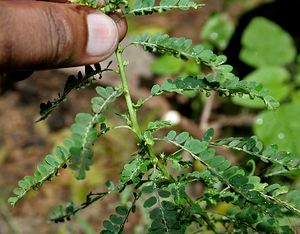Note: This is a project under development. The articles on this wiki are just being initiated and broadly incomplete. You can Help creating new pages.
Phyllanthus amarus - Bhuamlaki
Phyllanthus amarus is widely used as a medicinal plant in Ayurvedic medicine. A suppository of the leaf paste is applied to the vagina to treat absence of menstruation and polyps. Leaf sap, mixed with palm oil or not, is applied as ear drops to treat otitis and applied to abscesses, sores and wounds.
Contents
[hide]- 1 Uses
- 2 Parts Used
- 3 Chemical Composition
- 4 Common names
- 5 Properties
- 6 Habit
- 7 Identification
- 8 List of Ayurvedic medicine in which the herb is used
- 9 Where to get the saplings
- 10 Mode of Propagation
- 11 How to plant/cultivate
- 12 Commonly seen growing in areas
- 13 Photo Gallery
- 14 References
- 15 External Links
Uses
Diarrhea, Cold, Fever, Gynecology, Arthritis, Diabetes, Backache[1]
Parts Used
Chemical Composition
Numerous phytochemicals such as alkaloids, flavonoids, tannins, lignans and polyphenolics as well as tetracyclic triterpenoids have identified etc.[2]
Common names
| Language | Common name |
|---|---|
| Kannada | Kempu Nela nelli |
| Hindi | Bhuy aamla |
| Malayalam | Keezhar nelli |
| Tamil | Keezha nelli |
| Telugu | Neala usiri |
| Marathi | NA |
| Gujarathi | NA |
| Punjabi | NA |
| Kashmiri | NA |
| Sanskrit | Bhumyamalaki |
| English | Carry me seed |
Properties
Reference: Dravya - Substance, Rasa - Taste, Guna - Qualities, Veerya - Potency, Vipaka - Post-digesion effect, Karma - Pharmacological activity, Prabhava - Therepeutics.
Dravya
Rasa
Guna
Veerya
Vipaka
Karma
Prabhava
Habit
Identification
Leaf
| Kind | Shape | Feature |
|---|---|---|
| Alternate | Elliptic to oblong | Each branch has 12-32 leaves. The leaves are elliptic to oblong, to 1.5 cm, with an entire margin and with a rounded or apiculate leaf apex |
Flower
| Type | Size | Color and composition | Stamen | More information |
|---|---|---|---|---|
| Very small cymes | Bright yellow | 3 stamens | The 1st and 2nd cymes nearest the man stem have only staminate flowers. Flowering season is throughout the year |
Fruit
| Type | Size | Mass | Appearance | Seeds | More information |
|---|---|---|---|---|---|
| Capsule | 7.5–11 cm long, 1.5 cm broad | A dry capsule, dehiscent, vertically muriculate. Fruiting throughout the year | Seeds 6 | Fruiting season is throughout the year |
Other features
List of Ayurvedic medicine in which the herb is used
Amritapaasha, Amritapaasha Grita, Actilive forte, Ayurviya, Improval, Ictrus, Imidige, Curelive, Chavanapraash, Chavanapraash Lehyam, Japapatriyaadi Tailam, Nasollerine Capsule, Pippalyadi Gritham, Madhunivar, Restolive, Livelon Forte, Lecofit, Vimlive, Shatavari Gudam, Shatavari Lehyam, Suriya[1]
Where to get the saplings
Mode of Propagation
How to plant/cultivate
Requires a sunny position. Sandy loam and black soils with a pH of 7.5 - 8 are considered best.[4]
Commonly seen growing in areas
Tropical area, Subtropical area, Drained sandy-loam soil.
Photo Gallery
References
- ↑ Jump up to: 1.0 1.1 1.2 "Karnataka Medicinal Plants Volume - 2" by Dr.M. R. Gurudeva, Page No.533, Published by Divyachandra Prakashana, #45, Paapannana Tota, 1st Main road, Basaveshwara Nagara, Bengaluru.
- Jump up ↑ Chemical constituents
- Jump up ↑ Kappatagudda - A Repertoire of Medicianal Plants of Gadag by Yashpal Kshirasagar and Sonal Vrishni, Page No. 304
- Jump up ↑ Cultivation Details
External Links
- Ayurvedic Herbs known to be helpful to treat Diarrhea
- Ayurvedic Herbs known to be helpful to treat Cold
- Ayurvedic Herbs known to be helpful to treat Fever
- Ayurvedic Herbs known to be helpful to treat Gynecology
- Ayurvedic Herbs known to be helpful to treat Arthritis
- Ayurvedic Herbs known to be helpful to treat Diabetes
- Ayurvedic Herbs known to be helpful to treat Backache
- Herbs with Whole plant used in medicine
- Herbs with common name in Kannada
- Herbs with common name in Hindi
- Herbs with common name in Malayalam
- Herbs with common name in Tamil
- Herbs with common name in Telugu
- Herbs with common name in Sanskrit
- Herbs with common name in English
- Habit - Annual herb
- Index of Plants which can be propagated by Seeds
- Herbs that are commonly seen in the region of Tropical area
- Herbs that are commonly seen in the region of Subtropical area
- Herbs that are commonly seen in the region of Drained sandy-loam soil
- Herbs
- Phyllanthaceae
- Pages without herbs images


